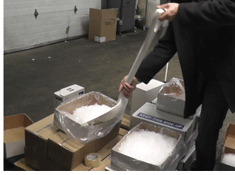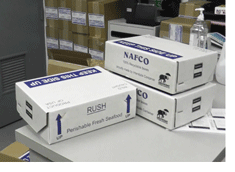 |
||||||||
| April 16, 2014 | ||||||||
| Doctoring 101 - Solutions to common doctoring problems |  |
|||||||
| · www.tappi.org · Subscribe to Ahead of the Curve · Newsletters · Ahead of the Curve archived issues · Contact the Editor |
Greener Packaging for Boston (Editor's Note: Based on a Global Green press release of March 19, 2013) Demonstrating that recyclable packaging can survive one of NAFCO’s [the largest regional seafood distributor in the Mid-Atlantic] longest shipping routes, Global Green USA coordinated a pilot in which water-resistant packaging that is 100% recyclable with regular cardboard could be used to bring Chesapeake Bay seafood five hundred miles to a Boston location of a major grocery chain. Global Green USA, building on previous successful recyclable packaging tests, came to the heart of New England for the next installment of the pilot series. With the help of a grocer and one of their primary seafood suppliers, Global Green USA documented the ice-packing of water-resistant, recyclable boxes made by Cascades and Interstate Container and shipped to a location in Boston, just in time for the last day of the Boston Seafood Expo on March 18th. As the boxes were unloaded, all present confirmed that they had performed well, indicating that future shipments could also be sent in the strong, water-resistant, recyclable packaging. “Sustainability goes beyond the seafood harvest—packaging matters,” said Global Green USA’s Lily Kelly, Senior Program Associate for CoRR and the pilot coordinator. “The good news, from an environmental standpoint, is that packaging is available today that protects the seafood, can be recycled after its job is done, and is cost-competitive with the usual unrecyclable expanded polystyrene [EPS] and wax-coated packaging. If all unrecyclable corrugated packaging were replaced with recyclable alternatives, and recycled, the greenhouse gas emissions reduction would be equivalent to shutting down an entire coal-fired power plant with no energy loss, and grocers and restaurants would save $200 million.” Ian Page, Vice President of Quality Assurance at NAFCO, was also pleased that the recyclable boxes performed well over the course of the multi-day and multi-stage shipping process. “It’s our goal to provide the best possible product, and to support our customers in all of their sustainability goals,” he said. “We are excited to have worked with Global Green USA to assess some of the recyclable boxes available, and we hope to eventually be able to provide 100% recyclable packaging with all our products.” The boxes, which were donated for testing by Cascades and Interstate Container, are made from recycled material, and are recyclable in accordance with the Fibre Box Association’s recyclability and repulpability protocol for wax-alternative coatings. “While Interstate Container’s roots are in poultry, our Greencoat ICE boxes for seafood are also working extremely well. Retailers need to know there are options to non-recyclable wax and EPS packaging. A switch to a recyclable box is not only fantastic for the environment, but also a savings to the bottom line for the packer, distributor, and retailer.” Olivier Doiron, Sales Representative for Cascades Industrial Packaging, echoed these sentiments. "Our Extreme H2O box is specifically designed for replacement of waxed boxes, and our Thermafresh box is a substitute for traditional EPS containers," he said "We use a non-wax coating that keeps the box strong, but make it easy to recycle it with regular cardboard. Our customers find that it adds value when they use recyclable packaging; what was a cost of getting rid of waste material now becomes a revenue stream for the grocer or restaurant who receives the seafood." This pilot marks a step toward more sustainable food systems: Greens, vegetables, seafood, and meats are often transported in paraffin-coated cardboard, generating 1.45 million tons of solid waste that must be sent to landfills or burned. Old corrugated cardboard is the most widely recovered packaging material in the country (91% recovered, according to the US EPA), meaning that if this packaging were recyclable it could be collected and recovered in nearly every community in the U.S. For more information contact Lily Kelly.
Now that you
are Ahead of the Curve, stay there by joining TAPPI. |
|||||||
 |
||||||||




